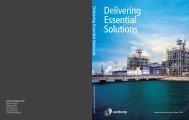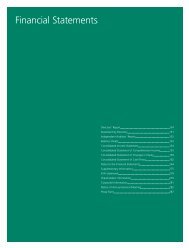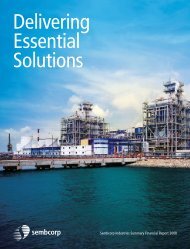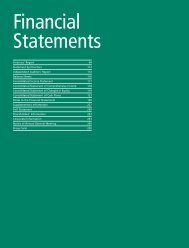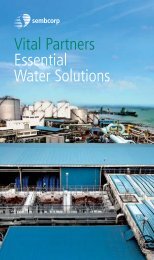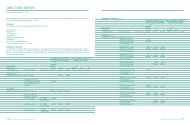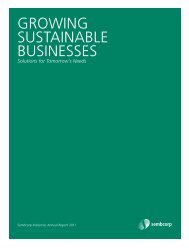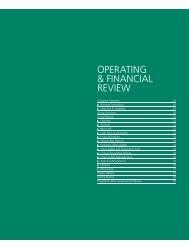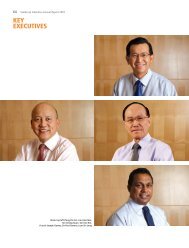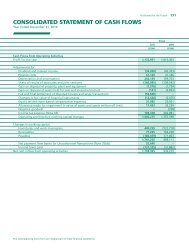FINANCIAL STATEMENTS (Full Version) - Sembcorp
FINANCIAL STATEMENTS (Full Version) - Sembcorp
FINANCIAL STATEMENTS (Full Version) - Sembcorp
You also want an ePaper? Increase the reach of your titles
YUMPU automatically turns print PDFs into web optimized ePapers that Google loves.
Notes to the<br />
Financial Statements<br />
Year Ended December 31, 2008<br />
2. SUMMARY OF SIGNIFICANT ACCOUNTING POLICIES (cont’d)<br />
d. Property, Plant and Equipment (cont’d)<br />
iv. Disposals<br />
Gains or losses arising from the retirement or disposal of property, plant and equipment are determined as<br />
the difference between the estimated net disposal proceeds and the carrying amount of the asset and are<br />
recognised in the income statement on the date of retirement or disposal.<br />
For property, plant and equipment carried at revalued amounts, any related revaluation surplus is transferred<br />
from the revaluation reserve to accumulated profits and is not taken into account in arriving at the gain or<br />
loss on disposal.<br />
v. Finance Lease Assets<br />
Finance leases are those leasing agreements that give rights approximating to ownership. Property, plant and<br />
equipment acquired by way of such leases is capitalised at the lower of its fair value and the present value<br />
of the minimum lease payments at the inception of the lease, less accumulated depreciation and impairment<br />
losses.<br />
Lease payments are apportioned between the finance charges and reduction of the lease liability so as to<br />
achieve a constant rate of interest on the remaining balance of the liability.<br />
Finance charges are charged directly to the income statement.<br />
Capitalised leased assets are depreciated over the shorter of the economic useful life of the asset and the lease<br />
term.<br />
vi. Provision for Restoration Costs<br />
A provision is recognised for the costs expected to be incurred to dismantle, remove and restore the asset upon<br />
expiry of the lease agreement. The estimated costs form part of the cost of the property, plant and equipment<br />
and are depreciated over the useful life of the asset.<br />
vii. Depreciation<br />
Depreciation is calculated using the straight-line method to allocate the cost less its residual value so as to write<br />
off items of property, plant and equipment over their estimated useful lives. Each part of an item of property,<br />
plant and equipment with a cost that is significant in relation to the total cost of an item is depreciated<br />
separately. The estimated useful lives are as follows:<br />
2. SUMMARY OF SIGNIFICANT ACCOUNTING POLICIES (cont’d)<br />
e. Investment Properties<br />
Investment properties comprise significant portions of office buildings and freehold land that are held for longterm<br />
rental yields or for capital appreciation, or both.<br />
Investment properties are initially recognised at cost and subsequently carried at cost less accumulated depreciation<br />
and accumulated impairment losses. Depreciation is recognised in the income statement on a straight-line basis<br />
over the estimated useful lives ranging from 20 to 50 years. The assets’ depreciation methods, useful lives and<br />
residual values are reviewed, if not insignificant, annually, and adjusted if appropriate. No depreciation is provided<br />
on the freehold land.<br />
Investment properties are subject to renovations or improvements at regular intervals. The cost of major<br />
renovations and improvements is capitalised as additions and the carrying amounts of the replaced components<br />
are written off to the income statement. The cost of maintenance, repairs and minor improvements is charged to<br />
the income statement when incurred.<br />
On disposal of an investment property, the difference between the estimated net disposal proceeds and the<br />
carrying amount of the asset is recognised in the income statement.<br />
f. Intangible Assets<br />
i. Goodwill<br />
Goodwill represents the excess of the cost of acquisition over the fair value of the Group’s share of the<br />
identifiable net assets. Goodwill is stated at cost less accumulated impairment losses. Goodwill on acquisition<br />
of subsidiaries is included in intangible assets. Goodwill on acquisition of associates and joint ventures is<br />
included in investments in associates and joint ventures.<br />
ii.<br />
Goodwill arising from the acquisition of a minority interest in a subsidiary represents the excess of the cost of<br />
the additional investment over the carrying amount of the net assets acquired at the date of exchange.<br />
Goodwill is tested for impairment on an annual basis in accordance with Note 2(n).<br />
Goodwill / Negative Goodwill Previously Written Off Against Reserves<br />
Goodwill that has previously been taken to reserves is not taken to the income statement when (i) the business<br />
is disposed of or discontinued or (ii) the goodwill is impaired. Similarly, negative goodwill that has previously<br />
been taken to reserves is not taken to the income statement when the business is disposed of or discontinued.<br />
Leasehold land and wet berthage<br />
Land improvements<br />
Buildings<br />
Improvements to premises<br />
Quays and dry docks<br />
Floating docks<br />
Plant and machinery<br />
Marine vessels<br />
Furniture, fittings and office equipment<br />
Tools and workshop equipment<br />
Motor vehicles<br />
Lease period ranging from 20 to 60 years<br />
Lease period ranging from 20 to 60 years<br />
50 years or lease period ranging from 10 to 50 years, if lower<br />
1 to 10 years<br />
15 to 60 years<br />
20 years<br />
3 to 40 years<br />
3 to 25 years<br />
1 to 10 years<br />
3 to 10 years<br />
2 to 10 years<br />
iii. Research and Development<br />
Expenditure on research activities, undertaken with the prospect of gaining new scientific or technical<br />
knowledge and understanding, is recognised in the income statement as an expense as incurred.<br />
Expenditure on development activities, whereby research findings are applied to a plan or design for the<br />
production of new or substantially improved products and processes, is capitalised if the product or process<br />
is technically and commercially feasible and the Group has sufficient resources to complete development.<br />
The expenditure capitalised includes the cost of materials, direct labour and an appropriate proportion of<br />
overheads. Other development expenditure is recognised in the income statement as an expense as incurred.<br />
Capitalised development expenditure is stated at cost less accumulated amortisation and impairment losses.<br />
The assets’ useful lives and residual values are reviewed, if not insignificant, annually, and adjusted if appropriate.<br />
No depreciation is provided on freehold land and capital work-in-progress.<br />
Amortisation is charged to the income statement on a straight-line basis over the estimated useful life of 10 years.<br />
<strong>Full</strong>y depreciated assets are retained in the financial statements until they are no longer in use.<br />
124 Delivering Essential Solutions <strong>Sembcorp</strong> Industries Annual Report 2008 125



